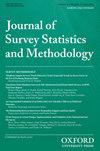将适应性调查设计纳入两阶段国家网络或邮件混合模式调查:美国家庭健康研究的实验
IF 1.6
4区 数学
Q2 SOCIAL SCIENCES, MATHEMATICAL METHODS
引用次数: 0
摘要
摘要本文介绍了美国家庭健康研究(AFHS)两阶段全国概率网络或邮件混合模式调查中家庭和个人招募的适应性设计实验结果。在筛选阶段,我们基于Esri Tapestry细分的自适应设计的子群区分。我们为西班牙裔人口占高比例的子样本使用了定制的邀请材料,并在初始邮寄中为农村和老年家庭的子样本添加了纸质问卷。在主要调查阶段,适应性设计的目标是家庭,其中一个成员以外的筛选受访者被选中进行调查。这些调整包括发电子邮件和/或短信,额外的预付奖励,以及寻求筛选受访者的帮助来提醒被选中的人。主要的研究问题是:(i)适应性设计是否改善了调查生产结果,(ii)与单独进行调查后调整相比,适应性设计和调查后加权调整相结合是否改善了调查估计。不幸的是,适应性设计并没有改善调查生产结果。我们发现加权AFHS估计值与基准全国面对面调查(全国家庭增长调查)的估计值非常相似,尽管适应性设计没有额外改变加权调整之外的调查估计值。尽管如此,我们的实验对在自我管理的邮件招聘网络或邮件调查中实施自适应设计产生了有用的见解。我们能够识别出具有潜在较低回复率和独特特征的子群体,但在两种主要调查模式和AFHS运营预算的限制下,为这些子群体制定有效的方案是具有挑战性的。此外,对于自我管理的家庭内部选择,很难从没有回应筛选访谈的选定家庭成员那里获得联系信息,接触和招募。本文章由计算机程序翻译,如有差异,请以英文原文为准。
Incorporating Adaptive Survey Design in a Two-Stage National Web or Mail Mixed-Mode Survey: An Experiment in the American Family Health Study
Abstract This article presents the results of an adaptive design experiment in the recruitment of households and individuals for a two-stage national probability web or mail mixed-mode survey, the American Family Health Study (AFHS). In the screening stage, we based the adaptive design’s subgroup differentiation on Esri Tapestry segmentation. We used tailored invitation materials for a subsample where a high proportion of the population was Hispanic and added a paper questionnaire to the initial mailing for a subsample with rural and older families. In the main-survey stage, the adaptive design targeted the households where a member other than the screening respondent was selected for the survey. The adaptations included emailing and/or texting, an additional prepaid incentive, and seeking screening respondents’ help to remind the selected individuals. The main research questions are (i) whether the adaptive design improved survey production outcomes and (ii) whether combining adaptive design and postsurvey weighting adjustments improved survey estimates compared to performing postsurvey adjustments alone. Unfortunately, the adaptive designs did not improve the survey production outcomes. We found that the weighted AFHS estimates closely resemble those of a benchmark national face-to-face survey, the National Survey of Family Growth, although the adaptive design did not additionally change survey estimates beyond the weighting adjustments. Nonetheless, our experiment yields useful insights about the implementation of adaptive design in a self-administered mail-recruit web or mail survey. We were able to identify subgroups with potentially lower response rates and distinctive characteristics, but it was challenging to develop effective protocol adaptations for these subgroups under the constraints of the two primary survey modes and the operational budget of the AFHS. In addition, for self-administered within-household selection, it was difficult to obtain contact information from, reach, and recruit selected household members that did not respond to the screening interview.
求助全文
通过发布文献求助,成功后即可免费获取论文全文。
去求助
来源期刊
CiteScore
4.30
自引率
9.50%
发文量
40
期刊介绍:
The Journal of Survey Statistics and Methodology, sponsored by AAPOR and the American Statistical Association, began publishing in 2013. Its objective is to publish cutting edge scholarly articles on statistical and methodological issues for sample surveys, censuses, administrative record systems, and other related data. It aims to be the flagship journal for research on survey statistics and methodology. Topics of interest include survey sample design, statistical inference, nonresponse, measurement error, the effects of modes of data collection, paradata and responsive survey design, combining data from multiple sources, record linkage, disclosure limitation, and other issues in survey statistics and methodology. The journal publishes both theoretical and applied papers, provided the theory is motivated by an important applied problem and the applied papers report on research that contributes generalizable knowledge to the field. Review papers are also welcomed. Papers on a broad range of surveys are encouraged, including (but not limited to) surveys concerning business, economics, marketing research, social science, environment, epidemiology, biostatistics and official statistics. The journal has three sections. The Survey Statistics section presents papers on innovative sampling procedures, imputation, weighting, measures of uncertainty, small area inference, new methods of analysis, and other statistical issues related to surveys. The Survey Methodology section presents papers that focus on methodological research, including methodological experiments, methods of data collection and use of paradata. The Applications section contains papers involving innovative applications of methods and providing practical contributions and guidance, and/or significant new findings.

 求助内容:
求助内容: 应助结果提醒方式:
应助结果提醒方式:


